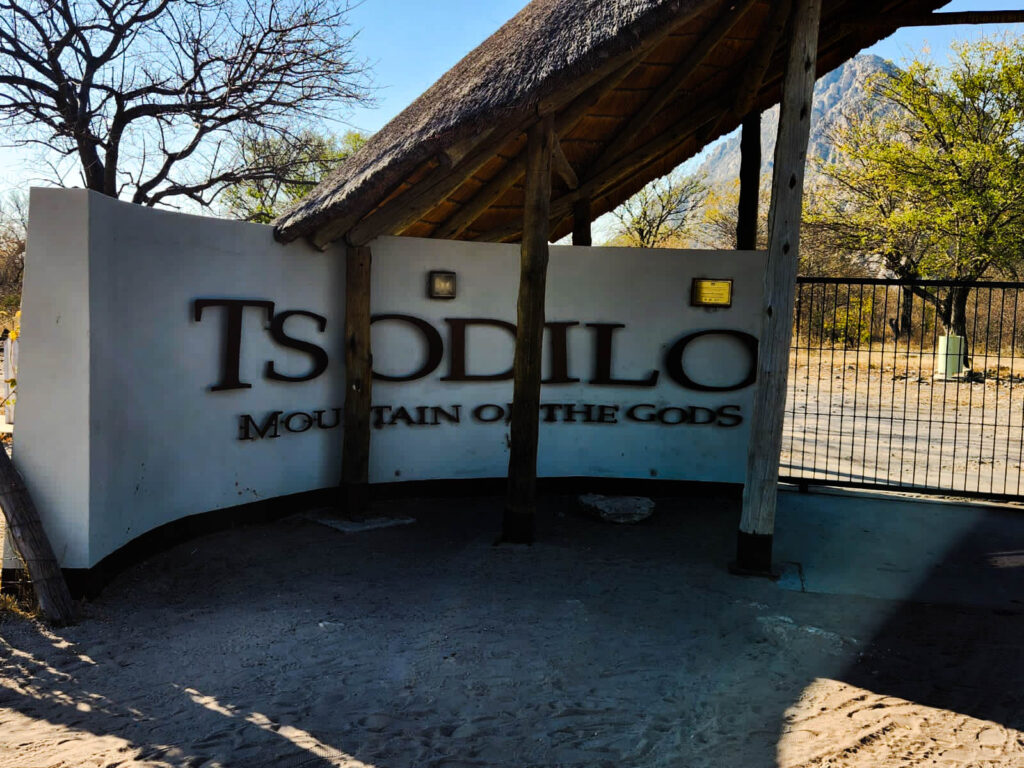I have visited most of the sacred sites in the world that have awakened the Inner Self and evoked deep revere for Mother Nature. Some of these experiences have been captured in my book, “Odyssey of a Healer.” I have always been drawn to connect deeply with this sacred site, Tsodilo Hills. Every whisper that was heard in silence became an irresistible magnetic whirlpool. Furthermore, the timing of the visit was of prime importance, the 2023 Winter Solstice in the Southern hemisphere, also called hibernal solstice. A period marked by the shortest day of the year with the earliest sunset and the first day of winter in the astronomical calendar.
Tsodilo Hills, a sacred place for the San, who call them the “Mountains of the Gods” and the “Rock that Whispers.” I pondered on these veneration sayings by the San. In my own opinion based on the recent experience at the site. I have awoken to the realization that Mother Nature affords the pilgrim the opportunity to see the unseen and to hear the unspoken depending on whether the seeker is ripe to be the recipient of her gentle whispers. I harbour a deep-rooted belief that Direct Knowing is achieved through the embodiment of the experience itself. Becoming one with the experience opens the avenue for compassionate knowing. The partaker in the sacred experience becomes the friend not an intruder. The experience is regarded as neither the subject nor the object having merged in oneness.
Sacred libraries etched in Stone,
Please help me find my way;
Symbols of all Earth has known,
Mark the language you display…
Silent messenger of the Earth,
My teacher made of Stone,
I honour your seed of wisdom
And the knowing you have sown[1].
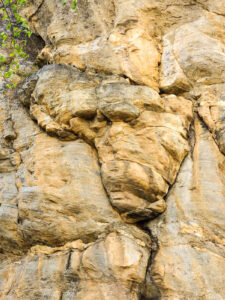
Tsodilo is situated in the north-western corner of Botswana near Namibian Border. Rising majestically from where the Kgalagadi sands meet the rich dense vegetation of the Okavango wetlands. This visit once more reignited within me the Ancient ways of Being and Knowing that are deeply woven in my matrix. It filled my Being with state of awe and deep admiration. Tsodilo hills is known to have been a place of peace, refuge and spiritual fulfilment to different groups of people in the past and today. There are some individuals that visit Tsodilo to fetch water from the ancestral well for religious rituals while the local hunters use specific spots on the hills to perform hunting rituals.
We are informed through oral tradition and archeological studies conducted on site that the earliest people to inhabit Tsodilo were Middle Stone Age people 100 000 years ago. They were the first anatomically modern humans (Homo apiens). Evidence from excavations tells us that these small groups of people camped for brief periods in the many rock shelters in the hills. People from Middle and Late Stone Age would have lived entirely by hunting, collecting wild foods and fishing in the lake that existed in Tsodilo between 22 500 and 7500 years ago.
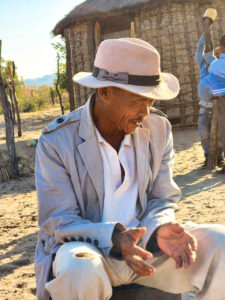
The current residents of Tsodilo are the !Kung and Hambukushu who settled here in 1800. I had the privilege of been taken on a guided tour by their Elder, Quntae. He liberally shared more spiritual insight about Tsodilo Hills as we visited the sacred caves and observed the Rock Art paintings. According to their legend mankind descended from the Great Python, and the ancient, arid streambeds around the hills are said to have been created by the Python as it circled the hills in its ceaseless search for water.
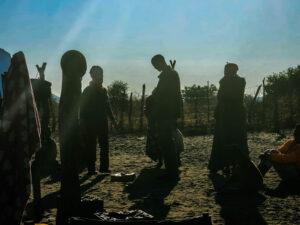
For me this was an auspicious visit marked by the winter solstice. A period that serpents are known to go into hibernation and shed off their skin, symbolic of the process of death and rebirth. A time for slowing down, reflecting, and turning inward for the primal purpose of cultivating deeper connection with our intuition. A significant period of lifting of the veiling allowing the light to pierce through the Darkness in order to be afforded the much-needed insight during this period of Great Shift upon us.
Kindly allow me to share this poem of the Great Python from the book: Odyssey of a Healer
The Great Mother of All…. is calling
The moment is ripe
Enter into my womb to be reborn
Bathe yourself in my living waters
Allow me to gently peel off the old skin
Shatter the veils of illusion obscuring your vision
Let the radiance of your renewed skin
Sends beams of light to the Sky-God
Marking the joy of rebirth
Of the Sons and Daughters of the Great Python[2]
Information gathered from Tsodilo Hills Museum revealed that over the last two decades, a number of investigations have helped form a picture of ancient life in this Mountain of the Gods, Tsodilo Hills. The three rock shelters: White Paintings Shelter, Depression Shelter and Rhino Cave have been excavated. Over twenty mines and the remains of two villages of Divuyu and N!oma dating back to 500 AD have been discovered. From these two sites we know of local communities and immigrants from the Zambezi and Congo regions who were involved in trade, body decoration, the production of stone tools, pottery and jewellery. Iron working and domestic animals were introduced in the area at around 650 AD. These people are known to have resided at Tsodilo until the 1850s when they moved to the Okavango Delta.
Tsodilo Hills, Place of Unique Natural Beauty
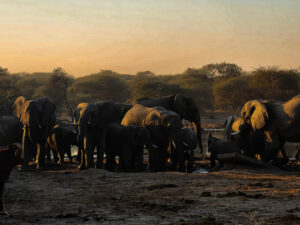
Tsodilo is a place of unique natural beauty that abound with plants and animals. It is regularly visited by herd of elephants. We encountered abundance of elephant’s poo while driving along the 35 km gravel road leading to the site. It became clear during this auspicious early sunset, that the great watchers, the Royal Elephants were welcoming us though making themselves physically invisible. We only had the opportunity to see them the following day. Tsodilo hills even today is home to the leopard, the antbear, brown hyena, African python, mamba, falcon, and the endemic gecko (Pachydactylus tsodiloensis).
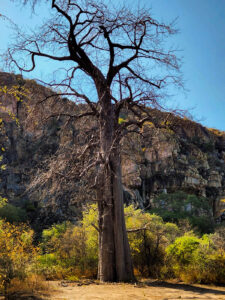
Oral traditions claim that Tsodilo is the home of the spirits of each animal and plant that has ever been created. The majestic Baobab Trees which are symbolic of the Tree of Life are a common feature that grace this holy site among other plants and trees. A deep knowledge of these plants is necessary because while most are beneficial some are very poisonous. Just to highlight some of these plants, they are as follows:
- Mongongo tree (Ricinodendron rautanei) which produces a nut with high protein content.
- Sengaparile shrub (Arpagophytum procumbens), commonly known as Kalahari Devil’s Claw is used as medication or treatment for high blood pressure.
- Sekaname tuber (Urgenia sanguine) is a poisonous tuber.
- Mogau shrub (Dichapetalum cymosum) which is often the first green growth of the summer season, is poisonous and deadly to cattle.
The Mystery Caves
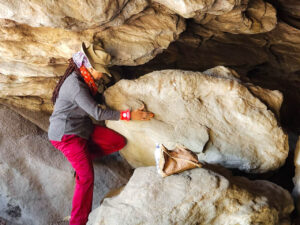
On the day we chose to enter the Python Cave for a sacred ceremony accompanied by the Khoi-San Elder,Quntae.
He immediately alerted us of the spotted footprints of a leopard that had walked through the cave during the night prior our day visit. For me it was very symbolic and a positive omen as we prepared ceremony in this Cave that house a rock sculpture of snake of 6metres in length and 2metres width which I have opted to refer to as the Great Python.
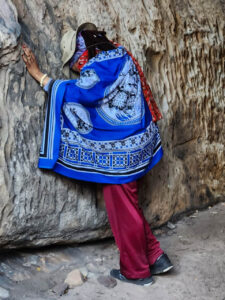
It is known that the first and oldest human ritual performed in the Python Cave dates to 70 000 years ago. These is supported by documented scientific studies conducted on site by Prof Sheila Coulson and her team from University of Olso. The startling discovery of 70,000-year-old artifacts and a python’s head carved of stone that appears to represent the first known human rituals.[3]
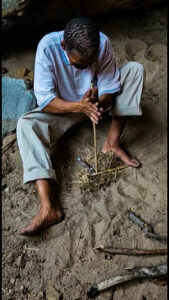
Their findings shows that people from the area had a specific ritual location associated with the python. The ritual was held in a little cave on the northern side of the Tsodilo Hills. The cave itself is so secluded and access to it is so difficult that it was not even discovered by archaeologists until the 1990s. Upon accessing the cave, they were struck by the mysterious rock that resembled the head of a huge python. It measured six meter long by two-meter-tall rock. In additions, they found three-to-four hundred indentations that could only have been man-made.
Prof Coulson stated, “You could see the mouth and eyes of the snake. It looked like a real python. The play of sunlight over the indentations gave them the appearance of snake skin. At night, the firelight gave one the feeling that the snake was moving”.
More significant discovery on the Python Cave, when Coulson and her colleagues dug a test pit near, they stone figure, they found spearheads made of stone that had to have been brought to the cave from hundreds of miles away. The spearheads were burned in what only could be described as some sort of ritual. The scientists concluded that “Stone age people took these colorful spearheads, brought them to the cave, and finished carving them there,” Coulson further stated that “Only the red spearheads were burned. It was a ritual destruction of artifacts. There was no sign of normal habitation. No ordinary tools were found at the site.”
The scientists found a secret chamber behind the python carving. Prof Coulson deduced that the shaman, who is still a very important person in San culture, could have kept himself hidden in that secret chamber thus affording him a good view of the inside of the cave while remaining hidden. When the shaman spoke from his hiding place, it could have created an impression that the voice came from the snake itself thus affording him greater control. The scientist postulated that the shaman could also have made himself disappear from the chamber by crawling out onto the hillside through a small shaft they found in the cave.
While cave paintings are common in the Tsodilo Hills, inside the python cave there are just two small paintings, of an elephant and a giraffe. The images were painted at the exact spot where water runs down the wall. One San story has the python falling into water, unable to get out. It is saved by the giraffe. The elephant, with its long trunk, is often a metaphor for the python in San mythology. The Python, the Elephant, and the Giraffe are the most important animal among the Khoisan.
Tsodilo Hills: Africa’s Premier Rock Art Sites
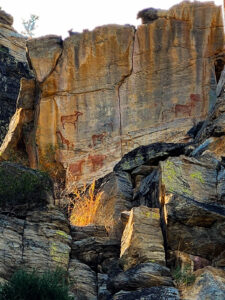
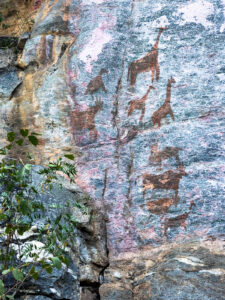
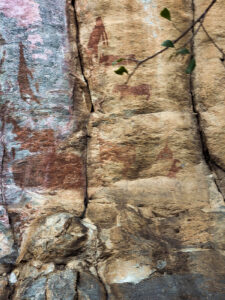
There are over 4500 images that have been painted at 400 sites. The red paintings are believed to have been painted by two different groups of people; the Ncaekhoe people and the Bantu people. These are finger paintings and are of two types i.e., red and white images. The red images were painted by Ncaekhoe and the white images were painted by the Bantu. The material that made the paint was probably obtained from hematite, charcoal, and calcrete. These were mixed with animal fat, blood, marrow, egg-white, sap, and urine.
The 4500 paintings depict wild animals, human figures, and geometric designs. Of the 4500 individual images, wild animals are the most dominant. These rock paintings that depict animals, humans and geometric designs were used for specific traditional healing rituals by medicine men. Furthermore, to the medicine men the animals serve as spirit guides and embody certain powers that are aligned with nature.
Spiritual Significance of Tsodilo Hills Serpent Cave
Baba Credo Mutwa, a high Sanusi who performed a ceremony at the Tsodilo Serpent Cave when he was very young. He did shed light on the spiritual significance of Tsodilo Hills Serpent Cave during the interactions I had with him. The Great Rock Shaped Python, that appears to have scales scraped out by shamans was a representation of the Milky Way, a revered Flower Star and an important portal gate for entry and exit into our galaxy by the Star Beings whom he referred as the Fiery Visitors.[4]
The pilgrims during their sacred ceremony of worship at the Cave uttered invocations to the serpent to send life-giving rain for bountiful harvest and preservation of their livelihood. It is well-known that the snake or serpent is associated with rain-making rituals among most indigenous people.
Baba Credo Mutwa disclosed some of his personal encounters with the Star Beings and further elaborated that Earth, the Blue Pearl as its known by the Star Beings is not the only planet upon which life exist and songs of life are heard. There are other fourteen worlds upon which life exist. Most of these worlds do not have oceans similar to the ones found on the Blue Pearl [Mother Earth]. However, some have huge freshwater lakes as big as the sea but not ocean. There are only two worlds covered with salt water of which one belongs to the Nommo people. The watery world of the Nommo dances around the Red Dog Star called Sirius. The Nommo people or Star Beings are the revered Progenitors of Life and the Masters of Water.
We are further informed by the Nommo People of Sirius that the race of humanity was once great among the stars, the leading race in the great clusters of Stars. They lost their rightful place in the Galaxy because they were war mongers driven by hatred and selfishness. The Great Assembly in the Star Kingdom awaits their return into the Galaxy which is heavily weighed on the reformation and recognition of the Oneness of our state of Being governed by Universal Love.

[1] Jamie Sams, Earth Medicine, Ancestors’Ways of Harmony for Many Moons (New York: Harper Collins, 1994) p4.
[2] Mmatheo Motsisi, Odyssey of a Healer (South Africa, Lesedi House 2017), p140.
[3] The Research Council of Norway. “World’s Oldest Ritual Discovered — Worshipped The Python 70,000 Years Ago.” ScienceDaily. ScienceDaily, 30 November 2006. <www.sciencedaily.com/releases/2006/11/061130081347.htm>.
[4] Mmatheo Motsisi, Odyssey of a Healer (South Africa, Lesedi House 2017), p190-191.

